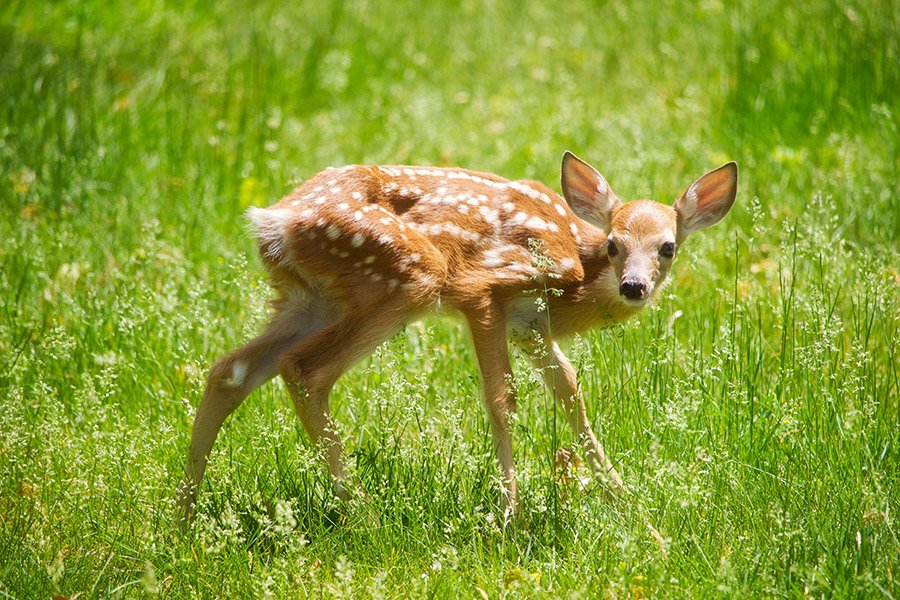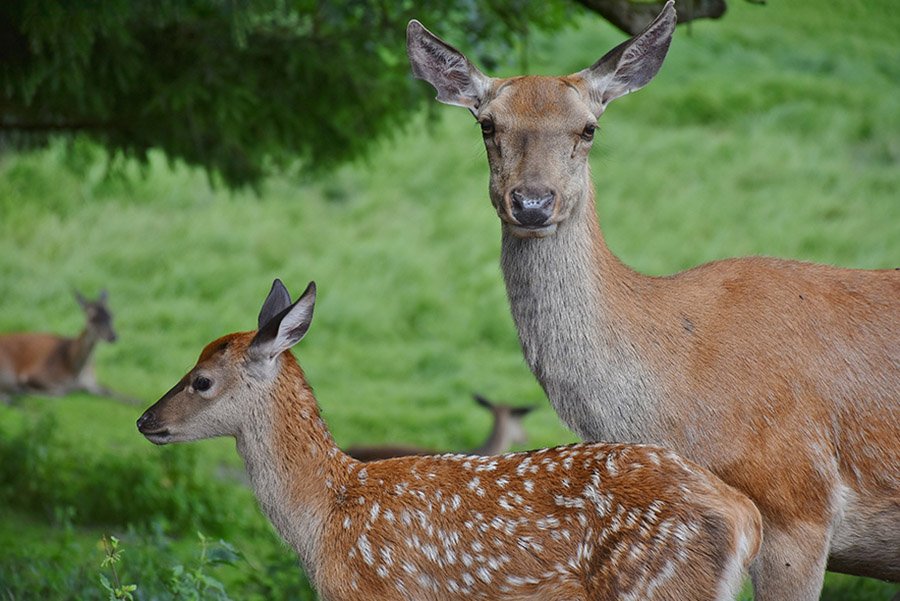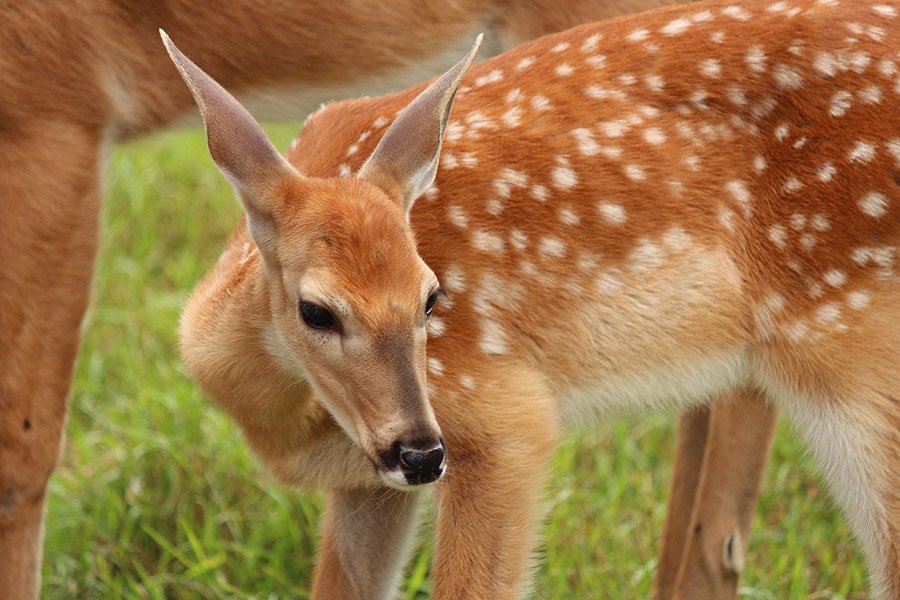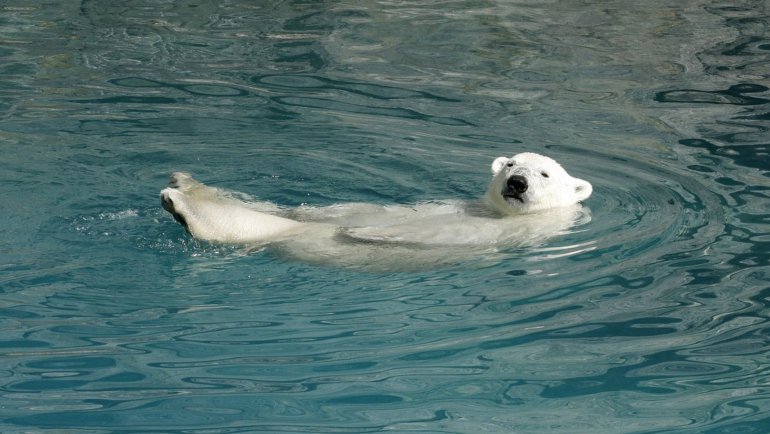Fawns are young deer known for their distinctive spotted coats. However, as they grow older, these spots gradually disappear. Many people may wonder why this happens and what purpose the spots serve in the first place.
Fortunately, this article has the information that will address all deer offspring queries.
Why Do Fawns Have Spots?
One of the main reasons for the fawn’s spotted coat is to camouflage. They are born with a dark red coat that helps them merge with the forest’s floor, also covered in brown and green hues.
Their coat’s white markings break up the outline of their body and make them harder to be seen by predators. The spots also mimic the sunlight rays that filter through the leaves and tree branches, which helps the fawn remain hidden in the forest.
These markings are vital in facilitating communication between the mother and the fawn. The mother can identify her fawn by its unique spot pattern, which helps her to locate and recognize it from afar.
The spots also help the fawn regulate its body temperature. In hot weather, the white spots on their coat reflect the sun’s rays and keep them cool. In contrast, during colder temperatures, the dark areas of their coat absorb heat and help to keep the fawn warm.
When Do Fawns Lose Their Spots?
Fawns typically lose their markings between 3 and 4 months of age; around the same time, they start to wean off milk and transition to solid foods.

As the fawn grows, its behavior and diet change, which can lead to a loss of spots. These young mammals become more active and explore their surroundings, so they no longer need to rely solely on their camouflage to protect themselves from predators.
The loss of spots is also linked to hormonal changes as the fawn matures. As they reach sexual maturity, the hormones in their body cause changes in their fur, including the loss of their spotted coat. Other physical changes, such as the growth of antlers in male deer, often accompany this change in fur coloration.
How Long Do Fawns Keep Their Spots?
Fawns usually keep their spots for about 2 to 4 months after birth. The markings typically start to fade and disappear gradually, with the dark areas of the coat becoming more dominant as the fawn grows.
When the fawn reaches four months, its coat is usually a uniform reddish-brown color without any spots. However, not all fawns lose their spots at the same rate or pattern. Some may lose their spots more quickly, while others may retain them longer.
Do All Baby Deer Have Spots?
Most deer species have spotted fawns, but there are some exceptions. For example, reindeer and caribou fawns possess a brownish-gray coat rather than a spotted one at birth. Additionally, some deer species, such as the Chinese water deer, have fawns with very faint spots.
Also read: Why You Should Never Touch a Baby Deer

How to Tell How Old a Fawn Is?
It can be challenging to determine the exact age of a fawn, but there are a few physical characteristics and behaviors that can give you an idea of how old the fawn is, which include:
Spots’ Color Intensity
Although all deer offspring have a dark red coat/fur with white markings at birth, the intensity and distinctness of their spots can enable you to estimate the age of a specific fawn.
For instance, fawns that are a few days old will have very bright, distinct markings, while older ones will have less defined spots that may have begun to fade.
Ear Length
A fawn’s ears will grow as it ages. A few days old fawns will have short, floppy ears, while an older fawn will have ears that are longer and more erect.
Eyes
Fawns are born with closed eyes, but they will begin to open them after a few days. When the fawn is a week old, its eyes should be fully open.
Behavior
Fawns become more active and mobile as they get older. A very young fawn will generally stay close to its mother and may not be able to stand or walk very well. Older ones will be more independent, curious about their surroundings, and likely to wander away from their mother.
Also read: Are Deer Nocturnal? When Are Deer Most Active?

Frequently Asked Questions
Are There Adult Deer With Spots?
While it is uncommon, there are cases where adult deer can have spots or retain some of their spotted patterns into adulthood. For instance, the Sika, Chital, and Fallow deer are known to maintain their fawn spots for more than a year or throughout their lifetime.
In some cases, adult deer can also develop spots due to certain medical conditions or injuries. For example, a deer that has lost patches of fur due to skin infection may have regrown fur that is lighter in color and appears as spots on its entire body coat.
However, while some adult deer may have spots, their overall coat coloration will differ from that of a fawn. Adult deer will have a more uniform coat color, while fawns will have a dark red coat with bright markings.
How Long Do Fawns Stay With Their Mother?
Fawns stay with their mothers for 6 to 12 months after birth. During this time, the mother will nurse and care for the fawn, teaching it essential survival skills such as foraging, avoiding predators, and socializing with other deer.
As it grows and becomes more independent, it will gradually spend more time away from its mother and may eventually leave to establish its territory.
How Long Can a Baby Deer Survive Without Its Mother?
Newborn deer can only survive a few hours without their mother’s milk and close company/warmth. Although young fawns (less than a week old) are also highly dependent on their mother for nutrition, care/protection, they are unlikely to survive for more than a few days (two to three days) without her.
However, the chances of surviving independently are significantly low when the fawn is in an unfavorable environment. For instance, during the winter, they require regular feeding and warmth from their mothers.
Additionally, if their habitat is highly infested with predators, the lone fawns may not even last minutes or hours alone since most predators prefer hunting vulnerable deer.
Do Bucks Take Care of Fawns?
Generally, bucks do not take an active role in caring for fawns. After mating with the doe, bucks leave to find another mate or establish their territory. Therefore, the doe is solely responsible for caring for and raising her offspring.
However, bucks may indirectly contribute to the survival of fawns by providing protection from predators. Alpha male deer are often aggressive and conscious in establishing dominance, vital in protecting their territory. This action significantly helps reduce the risk of fawn predation to those in that specific habitat.
How Long Do Deer Carry Their Babies?
In general, most species of deer have a gestation period of around 6 to 7 months. When the fawn(s) is born, it has to undergo a period of care and nursing from its mother to fully develop and survive independently.
How Long Before a Baby Deer Can Walk?
It typically takes fawns about 30 minutes to an hour after birth to stand on their own with the help of their mother. They usually wobble and fall over frequently during their first attempts at walking.
Healthy-born fawns can walk steadily within a few hours after birth, and they will begin to follow their mother around and explore their surroundings.
However, fawns may need a few days or weeks to develop the strength and coordination necessary for sustained running and jumping.
Final Thoughts
Since deer are facing multiple threats which has the potential to make them extinct, understanding some of the most vital features that nature has bestowed these mammals is essential.
One unique feature that enhances their survival chances is the spots covering their fawns’ bodies. As we’ve already seen, these markings allow them to camouflage/integrate with their surrounding environment, thus reducing predation risk.
Thanks to the information highlighted in this article, you are also aware of why they gradually lose their spots. Therefore, you are better positioned to play your part in conservation measures that will guarantee the successful continuation of deer generations.


